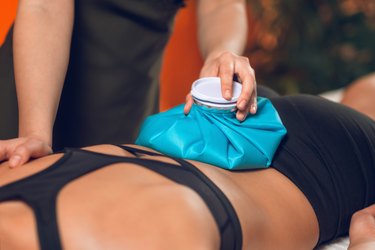
If your back hurts during exercise, rest assured that you are not alone. Most injuries are caused by over-training, improper body mechanics, inadequate conditioning or a combination of these. Some occur due to pre-existing problems with your back or spine.
Fortunately, most back pain heals quickly, but some injuries persist or get worse. Contact your doctor if your back hurts for more than three days or you have numbness, tingling or weakness anywhere in your body or loss of bowel or bladder control.
Video of the Day
Video of the Day
Tip
Lower back pain can be caused by a strain or pull due to over-training, improper form while exercising, lack of knowledge about the sport you're engaging in.
Muscle Strain Injury
The most common cause of muscle pain during exercise is a strained muscle. This injury typically occurs when you overestimate your strength or fail to use proper body mechanics when you perform an exercise, such as a pull down or a dead lift, that puts stress on your back.
Muscle strains also occur during twisting, bending or reaching movements and are particularly common in golfers due to the compression forces placed on the back during a typical golf swing according to the University of Texas Southwestern Medical Center. Even jazzercise can cause a strained muscle if you move the wrong way.
Although usually minor, these types of injuries cause inflammation, which leads to muscle spasms and severe pain. Icing the painful area and taking non-steroidal anti-inflammatory drugs such as ibuprofen may help the injury to heal more quickly, but the most important treatment is rest.
Spinal Disc Injury
The spinal column is made up of 24 bones, or vertebrae, which stabilize the back and protect the spinal cord according to the University of Washington Orthopaedics and Sports Medicine. Between these bones are gelatinous pads called intervertebral discs that help to facilitate movement of the spine and cushion the bones.
Under certain conditions, one or more of these discs may bulge, tear or slip out of place, causing nerve compression and severe pain. This often happens during contact sports such as football or when a basketball player jumps and then lands hard on his feet while twisting to block an opponent or make a shot.
It also can happen when you turn sideways while lifting a weight that is too heavy or if you fail to engage your core muscles during abdominal exercises such as crunches or leg lifts. Disc injuries typically resolve spontaneously with home remedies and rest followed by a program of strengthening exercises to stabilize your spine.
Or, if you're not confident of your own remedies, sign up for physiotherapy exercises for lower back pain. He might also prescribe back pain exercises you can do at home.
Sciatic Nerve Pain
Sciatica is a medical term that refers to pain caused by irritation of the sciatic nerve — a large nerve that originates in the lower back and continues down both legs and ends at the top of each foot according to the National Institute of Neurologic Disorders and Strokes.
Often caused by a bulging disc pressing on the nerve, sciatica is characterized by pain in the lower back, buttocks, thigh, knee or, less often, the foot. Running and jogging, especially without proper footwear, often cause sciatica due to the high-impact, repetitive stress these sports place on the lower back.
Learning good running form and warming up and stretching before you run are some of the best ways to keep sciatica at bay. Also, remember to replace your shoes when they begin to show signs of wear.
Spondylolisthesis in Athletes
One of the most common causes of back pain in younger athletes, spondylolisthesis is a condition in which one of the vertebrae slips behind or in front of the one below it, causing pain according to the American Academy of Orthopaedic Surgeons.
This injury is common in people who participate in sports that require twisting or hyperextension of the spine, such as gymnastics or golf. Symptoms include back pain that gets worse when you arch your back, tightness in your hamstrings, weakness in your legs and — in severe cases — a limp.
Typically, home remedies such as ice packs and rest can help alleviate the pain, after which you can begin a program of exercises to increase stability in your spine. Many golfers also benefit from changing their golf swing.
- University of Washington Orthopedics and Sports Medicine: "Back Pain"
- National Institute of Neurologic Disorders and Stroke: "Low Back Pain Fact Sheet"
- University of Texas Southwestern Medical Center: "Golfer’s Guide: 5 Ways to Avoid Back Pain"
- American Academy of Orthopaedic Surgeons: "Adult Spondylolisthesis in the Low Back"